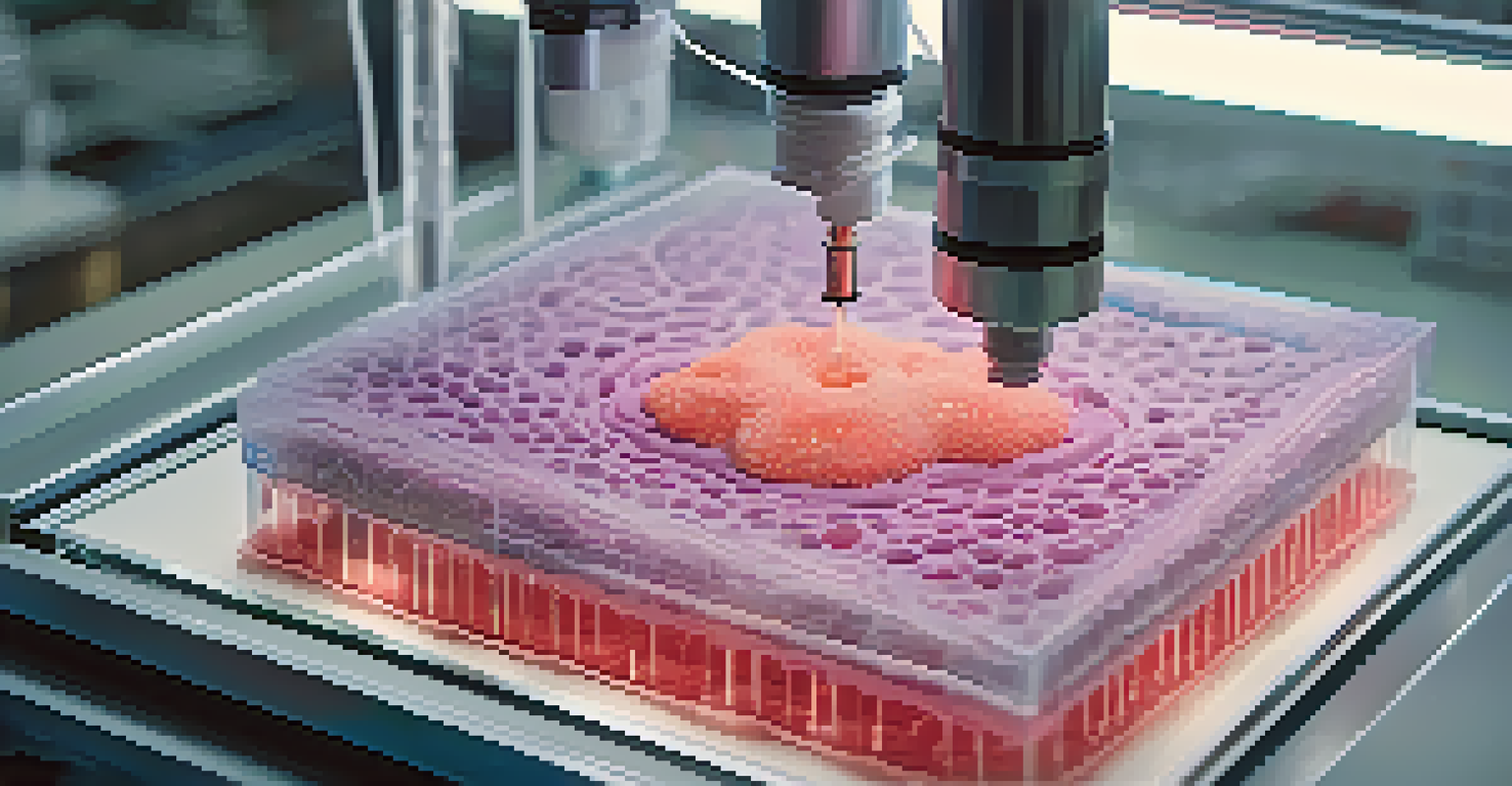Using Biomaterials in Regenerative Medicine: Key Insights

What Are Biomaterials and Their Role in Medicine?
Biomaterials are natural or synthetic substances engineered to interact with biological systems. They play a crucial role in regenerative medicine by providing scaffolding that supports tissue repair and regeneration. This interaction can promote healing and enhance the body’s natural processes, making them invaluable in medical applications.
Biomaterials represent a key advance in the field of regenerative medicine, allowing us to harness the body's own healing processes to restore function and health.
These materials can be found in various forms, including hydrogels, ceramics, and polymers, each suited for specific applications. For instance, hydrogels mimic the natural environment of cells, making them ideal for soft tissue engineering. The versatility of biomaterials allows researchers to tailor them to meet the unique needs of different medical scenarios.
As we continue to explore the capabilities of biomaterials, their integration into medical devices and therapies is becoming more sophisticated. This evolution highlights the importance of understanding both the material properties and the biological responses they elicit. Ultimately, the goal is to create solutions that significantly improve patient outcomes.
Types of Biomaterials Used in Regenerative Medicine
Biomaterials can be categorized into three main types: natural, synthetic, and hybrid. Natural biomaterials, such as collagen or chitosan, are derived from living organisms and are often biocompatible, meaning they are well-accepted by the body. Synthetic biomaterials, on the other hand, are man-made and can be engineered for specific properties, offering greater control over their behavior.

Hybrid biomaterials combine elements from both natural and synthetic sources, aiming to leverage the advantages of both. For example, a hybrid material might use a synthetic polymer framework but incorporate natural growth factors to promote cell growth. This combination can lead to improved performance in regenerative applications.
Biomaterials Enhance Healing
Biomaterials interact with biological systems to support tissue repair and regeneration, making them essential in regenerative medicine.
Choosing the right type of biomaterial is crucial for the success of regenerative therapies. Factors such as biocompatibility, mechanical strength, and degradation rates must be carefully considered. By understanding the characteristics of each type, researchers can make informed decisions that enhance therapeutic outcomes.
Current Applications of Biomaterials in Regenerative Medicine
Biomaterials are currently being used in a variety of regenerative medicine applications, including wound healing, cartilage repair, and organ regeneration. In wound healing, for instance, biomaterials can provide a temporary matrix for cell migration and tissue formation, accelerating the healing process. This application is particularly important for chronic wounds that resist healing.
The future of medicine lies in our ability to create materials that can interact positively with the human body, paving the way for innovative therapies.
Cartilage repair is another area where biomaterials shine. Researchers are developing scaffolds that can support the regeneration of cartilage, which is notoriously difficult to heal due to its limited blood supply. By using biomaterials that mimic the properties of natural cartilage, scientists hope to restore function and alleviate pain for patients suffering from joint disorders.
Moreover, advancements in 3D bioprinting are paving the way for creating complex tissue structures using biomaterials. This innovative approach allows for the fabrication of tissues that closely resemble natural organs, which could revolutionize transplantation medicine. The potential for biomaterials to facilitate organ regeneration opens exciting possibilities for the future of healthcare.
Challenges in Using Biomaterials for Regenerative Medicine
Despite their promise, the use of biomaterials in regenerative medicine is not without challenges. One major hurdle is ensuring biocompatibility, as the body can sometimes reject foreign materials. Researchers must carefully select and engineer biomaterials to minimize inflammatory responses and promote integration with surrounding tissues.
Another challenge is achieving the right mechanical properties for specific applications. For example, a scaffold used in bone regeneration must be strong enough to support weight, while one used for nerve regeneration must be flexible. Striking the right balance between mechanical strength and biological functionality is critical for successful outcomes.
Diverse Types of Biomaterials
Biomaterials can be natural, synthetic, or hybrid, each tailored for specific medical applications to optimize healing outcomes.
Finally, scalability remains a concern as researchers transition from laboratory settings to clinical applications. Developing biomaterials that can be produced in large quantities without compromising quality is essential for widespread adoption. Addressing these challenges will be key to unlocking the full potential of biomaterials in regenerative medicine.
Future Trends in Biomaterials for Regenerative Medicine
The future of biomaterials in regenerative medicine looks promising, with emerging trends that could reshape the field. One significant trend is the integration of smart biomaterials that can respond to environmental changes, such as pH or temperature. These materials can release therapeutic agents in a controlled manner, enhancing healing processes and patient outcomes.
Another exciting development is the use of nanotechnology to create biomaterials at the nanoscale. This approach allows for enhanced material properties and interactions at the cellular level, potentially leading to more effective therapies. Nanostructured materials can improve drug delivery and promote cell adhesion, making them ideal candidates for regenerative applications.
Additionally, personalized medicine is on the rise, with researchers exploring how to tailor biomaterials to individual patients. By considering a patient's unique biological makeup, scientists can design materials that optimize healing and reduce complications. The shift toward personalized regenerative therapies could revolutionize how we approach healing and recovery.
The Role of Research in Advancing Biomaterials
Research plays a crucial role in advancing the field of biomaterials and their applications in regenerative medicine. Through ongoing studies, scientists are continually uncovering new insights into how biomaterials interact with biological systems. This knowledge is essential for designing materials that can effectively support tissue regeneration.
Collaboration between researchers, clinicians, and industry partners is also vital for translating laboratory findings into clinical practice. By working together, these groups can identify real-world challenges and develop solutions that enhance the efficacy of biomaterials in medical settings. Such collaboration often leads to innovative products and therapies that benefit patients.
Future Trends in Biomaterials
Emerging trends like smart biomaterials and personalized medicine are set to redefine regenerative therapies and improve patient care.
Moreover, funding and support for biomaterials research are critical for fostering innovation. As more resources are dedicated to this field, researchers can explore new materials, techniques, and applications that could lead to breakthroughs in regenerative medicine. Continued investment in biomaterials research is essential for driving progress and improving patient care.
Conclusion: The Promise of Biomaterials in Regenerative Medicine
In conclusion, biomaterials hold immense promise for the future of regenerative medicine. Their ability to support and enhance the body's natural healing processes positions them as key players in treating various medical conditions. As we continue to explore their potential, the field is likely to see significant advancements that improve patient outcomes.
The ongoing research and development in this area are paving the way for new therapies that can restore function and quality of life for countless individuals. From wound healing to organ regeneration, the applications of biomaterials are vast and varied. Each advancement brings us closer to realizing the full potential of regenerative medicine.

Ultimately, the success of biomaterials in regenerative medicine will depend on addressing current challenges and embracing innovative solutions. By fostering collaboration and supporting research, we can unlock new possibilities for healing and recovery, transforming the landscape of healthcare for the better.